Monitoring River–Lake Dynamics in the Mid-Lower Reaches of the Yangtze River Using Sentinel-2 Imagery and X-Means Clustering
Abstract
Highlights
- A seasonal surface water area (SWA) product for the mid-lower Yangtze River (MLRYR) was developed using a multidimensional X-means clustering algorithm with Sentinel-2 imagery.
- Over the past six years, MLRYR’s SWA remained stable overall, but significant declines were observed in Poyang Lake, Dongting Lake, and Shijiu Lake, while Danjiangkou Reservoir showed the largest area increase.
- The study provides a robust framework for monitoring surface water dynamics, applicable to other regions, enhancing water resource management and conservation strategies.
- The findings reveal the complex interplay of climatic factors with hydrological buffering by river networks, informing targeted drought impact mitigation.
Abstract
1. Introduction
- (1)
- Employ VREWI [25], which offers improved performance over traditional water indices, together with a modified clustering algorithm to effectively discriminate water bodies. Based on Sentinel-2 imagery, it implements a precise and efficient method for hydrological network extraction. Furthermore, it constructs a new dataset tailored for large-scale river–lake system research, rigorously validating its accuracy.
- (2)
- Analyze the river–lake system dynamics in the sub-basins of the MLRYR over the past six years, identify the spatiotemporal change characteristics of rivers, lakes, and reservoirs, and reveal the spatiotemporal distribution characteristics of surface water in each sub-basin.
- (3)
- Analyze how large lakes and reservoirs in the sub-basins of the MLRYR respond to climatic events. Many basins worldwide encounter similar environmental challenges, such as climate change, reservoir construction, and rapid urbanization. Understanding the SWA in the MLRYR can provide valuable insights for the development and management of other basins.
2. Study Area and Dataset
2.1. Study Area
2.2. Data and Method
2.2.1. Remote Sensing Dataset
2.2.2. Auxiliary Data
2.3. Method
2.3.1. The Water Body Extraction Method
2.3.2. Lake Water Area Extraction
2.3.3. River Structure Extraction
2.3.4. Correlation Analysis Method
3. Result
3.1. Accuracy Assessment
3.2. Spatiotemporal Patterns and Changes of Surface Water in the MLRYR
3.2.1. Spatiotemporal Patterns of Surface Water in the MLRYR
3.2.2. Changes of Surface Water at the Sub-Basin Scale from 2018 to 2023
3.2.3. Temporal Changes in the Water Area of Large Lakes and Reservoirs
4. Discussion
4.1. Dynamics of River–Lake Systems and the Influence of Regional-Scale Factors on the Changes in River–Lake Systems
4.2. Our Findings Compared to Previous Research
4.3. Limitations and Future Research
5. Conclusions
Author Contributions
Funding
Data Availability Statement
Acknowledgments
Conflicts of Interest
References
- Chen, T.; Song, C.; Ke, L.; Wang, J.; Liu, K.; Wu, Q. Estimating Seasonal Water Budgets in Global Lakes by Using Multi-Source Remote Sensing Measurements. J. Hydrol. 2021, 593, 125781. [Google Scholar] [CrossRef]
- Broner, N.; Laronne, J.B.; Storz-Peretz, Y. Influence of Flood Events on the Response of Steep and Coarse-Grained Channels to Base-Level Lowering in an Arid Setting. J. Hydrol. 2024, 645, 132075. [Google Scholar] [CrossRef]
- Mack, E.A.; Theuerkauf, E.J.; Pepper, J.; Norton, R.K.; Bunting, E.L. Citizen Perceptions of Great Lakes Coastline Change and Management Efforts. Ocean Coast. Manag. 2024, 255, 107243. [Google Scholar] [CrossRef]
- Zhang, Y.; Du, J.; Guo, L.; Fang, S.; Zhang, J.; Sun, B.; Mao, J.; Sheng, Z.; Li, L. Long-Term Detection and Spatiotemporal Variation Analysis of Open-Surface Water Bodies in the Yellow River Basin from 1986 to 2020. Sci. Total Environ. 2022, 845, 157152. [Google Scholar] [CrossRef]
- Liu, Y.; Yuan, S.; Zhu, Y.; Ren, L.; Chen, R.; Zhu, X.; Xia, R. The Patterns, Magnitude, and Drivers of Unprecedented 2022 Mega-Drought in the Yangtze River Basin, China. Environ. Res. Lett. 2023, 18, 114006. [Google Scholar] [CrossRef]
- Zhang, Y.; Liu, X.; Wang, K.; Bai, P. Response of Evapotranspiration to the 2022 Unprecedented Extreme Drought in the Yangtze River Basin. Int. J. Climatol. 2024, 44, 2779–2791. [Google Scholar] [CrossRef]
- Pan, Y.; Teng, T.; Wang, S.; Wang, T. Impact and Mechanism of Urbanization on Urban Green Development in the Yangtze River Economic Belt. Ecol. Indic. 2024, 158, 111612. [Google Scholar] [CrossRef]
- Zhang, Q.; Kong, Q.; Zhang, M.; Huang, H. New-Type Urbanization and Ecological Well-Being Performance: A Coupling Coordination Analysis in the Middle Reaches of the Yangtze River Urban Agglomerations, China. Ecol. Indic. 2024, 159, 111678. [Google Scholar] [CrossRef]
- Xie, C.; Huang, X.; Mu, H.; Yin, W. Impacts of Land-Use Changes on the Lakes across the Yangtze Floodplain in China. Environ. Sci. Technol. 2017, 51, 3669–3677. [Google Scholar] [CrossRef]
- Xiong, Y.; Wang, K. Eco-Compensation Effects of the Wetland Recovery in Dongting Lake Area. J. Geogr. Sci. 2010, 20, 389–405. [Google Scholar] [CrossRef]
- Liu, D.; Dai, Q.; Yuan, G. Evolutionary Trends and Coordinated Development Analysis of Water Resources Systems and High-Quality Economic Growth in the Yangtze River Delta. Water 2023, 15, 4030. [Google Scholar] [CrossRef]
- Zhao, Y.; Liu, H.; Du, J.; Guo, C.; Xiao, L.; Yi, Y. Divergent Trends of Open Surface Water Body Area of River and Lake Dominated Regions in the Yangtze River Basin from 1986 to 2022. Remote Sens. 2025, 17, 1008. [Google Scholar] [CrossRef]
- Liu, H.; Zheng, L.; Jiang, L.; Liao, M. Forty-Year Water Body Changes in Poyang Lake and the Ecological Impacts Based on Landsat and HJ-1 a/B Observations. J. Hydrol. 2020, 589, 125161. [Google Scholar] [CrossRef]
- Yang, L.; Zhao, G.; Tian, P.; Mu, X.; Tian, X.; Feng, J.; Bai, Y. Runoff Changes in the Major River Basins of China and Their Responses to Potential Driving Forces. J. Hydrol. 2022, 607, 127536. [Google Scholar] [CrossRef]
- Yuan, W.; Chen, L.; Chen, H.; Deng, S.; Ji, H.; Liang, F. Assessing Habitat Quality at Poyang Lake Based on InVEST and Geodetector Modeling. Ecol. Evol. 2023, 13, e10759. [Google Scholar] [CrossRef]
- Xin, Z.; Li, Y.; Zhang, L.; Ding, W.; Ye, L.; Wu, J.; Zhang, C. Quantifying the Relative Contribution of Climate and Human Impacts on Seasonal Streamflow. J. Hydrol. 2019, 574, 936–945. [Google Scholar] [CrossRef]
- Günen, M.; Atasever, U. Remote Sensing and Monitoring of Water Resources: A Comparative Study of Different Indices and Thresholding Methods. Sci. Total Environ. 2024, 926, 172117. [Google Scholar] [CrossRef] [PubMed]
- Su, Z.; Xiang, L.; Steffen, H.; Jia, L.; Deng, F.; Wang, W.; Hu, K.; Guo, J.; Nong, A.; Cui, H.; et al. A New and Robust Index for Water Body Extraction from Sentinel-2 Imagery. Remote Sens. 2024, 16, 2749. [Google Scholar] [CrossRef]
- Sun, Q.; Li, J. A Method for Extracting Small Water Bodies Based on DEM and Remote Sensing Images. Sci. Rep. 2024, 14, 760. [Google Scholar] [CrossRef]
- Abad, L.; Hölbling, D.; Spiekermann, R.; Prasicek, G.; Dabiri, Z.; Argentin, A. Detecting Landslide-Dammed Lakes on Sentinel-2 Imagery and Monitoring Their Spatio-Temporal Evolution Following the Kaikoura Earthquake in New Zealand. Sci. Total Environ. 2024, 907, 168302. [Google Scholar] [CrossRef]
- Coffer, M.; Nezlin, N.; Bartlett, N.; Pasakarnis, T.; Lewis, T.; Digiacomo, P. Satellite Imagery as a Management Tool for Monitoring Water Clarity across Freshwater Ponds on Cape Cod, Massachusetts. J. Environ. Manag. 2024, 355, 120334. [Google Scholar] [CrossRef]
- Qi, Z.S.; Yao, S.M.; Zhu, Y.; Liu, X.Q. Research Progress on Evolution of Rivers and Lakes in China Based on Remote Sensing Technology. J. Change River Sci. Res. Inst. 2025, 42, 8–17. [Google Scholar] [CrossRef]
- Li, H.; Zech, J.; Ludwig, C.; Fendrich, S.; Shapiro, A.; Schultz, M.; Zipf, A. Automatic Mapping of National Surface Water with OpenStreetMap and Sentinel-2 MSI Data Using Deep Learning. Int. J. Appl. Earth Obs. Geoinf. 2021, 104, 102571. [Google Scholar] [CrossRef]
- Yang, X.; Qin, Q.; Grussenmeyer, P.; Koehl, M. Urban Surface Water Body Detection with Suppressed Built-up Noise Based on Water Indices from Sentinel-2 MSI Imagery. Remote Sens. Environ. 2018, 219, 259–270. [Google Scholar] [CrossRef]
- Wu, Q.; Wang, M.; Shen, Q.; Yao, Y.; Li, J.; Zhang, F.; Zhou, Y. Small water body extraction method based on Sentinel-2 satellite multi-spectral remote sensing image. Natl. Remote Sens. Bull. 2022, 26, 781–794. [Google Scholar] [CrossRef]
- Jiang, Z.; Wen, Y.; Zhang, G.; Wu, X. Water Information Extraction Based on Multi-Model RF Algorithm and Sentinel-2 Image Data. Sustainability 2022, 14, 3797. [Google Scholar] [CrossRef]
- Nie, Y.; Chen, Y.; Guo, J.; Li, S.; Xiao, Y.; Gong, W.; Lan, R. An Improved CNN Model in Image Classification Application on Water Turbidity. Sci. Rep. 2025, 15, 11264. [Google Scholar] [CrossRef]
- Parajuli, J.; Fernandez-Beltran, R.; Kang, J.; Pla, F. Attentional Dense Convolutional Neural Network for Water Body Extraction from Sentinel-2 Images. IEEE J. Sel. Top. Appl. Earth Obs. Remote Sens. 2022, 15, 6804–6816. [Google Scholar] [CrossRef]
- Li, J.; Meng, Y.; Li, Y.; Cui, Q.; Yang, X.; Tao, C.; Wang, Z.; Li, L.; Zhang, W. Accurate Water Extraction Using Remote Sensing Imagery Based on Normalized Difference Water Index and Unsupervised Deep Learning. J. Hydrol. 2022, 612, 128202. [Google Scholar] [CrossRef]
- Bangira, T.; Alfieri, S.M.; Menenti, M.; Van Niekerk, A. Comparing Thresholding with Machine Learning Classifiers for Mapping Complex Water. Remote Sens. 2019, 11, 1351. [Google Scholar] [CrossRef]
- Cordeiro, M.C.R.; Martinez, J.-M.; Peña-Luque, S. Automatic Water Detection from Multidimensional Hierarchical Clustering for Sentinel-2 Images and a Comparison with Level 2A Processors. Remote Sens. Environ. 2021, 253, 112209. [Google Scholar] [CrossRef]
- Yang, X.; Zhao, S.; Qin, X.; Zhao, N.; Liang, L. Mapping of Urban Surface Water Bodies from Sentinel-2 MSI Imagery at 10 m Resolution via NDWI-Based Image Sharpening. Remote Sens. 2017, 9, 596. [Google Scholar] [CrossRef]
- Liu, Z.; Chao, N.; Chen, G.; Zhang, G.; Wang, Z.; Li, F.; Ouyang, G. Changes in Monthly Surface Area, Water Level, and Storage of 194 Lakes and Reservoirs in the Yangtze River Basin during 1990–2021 Using Multisource Remote Sensing Data. Sci. Total Environ. 2024, 944, 173840. [Google Scholar] [CrossRef]
- Ye, X.; Wu, J.; Li, X.; Li, Y.; Zhang, Q.; Xu, C.-Y. Multi-Source Remote Sensing Data and Image Fusion Technology Reveal Significant Spatiotemporal Heterogeneity of Inundation Dynamics in a Typical Large Floodplain Lake System. J. Hydrol. Reg. Stud. 2023, 50, 101541. [Google Scholar] [CrossRef]
- Chen, L.; Liu, Y.; Li, J.; Tian, P.; Zhang, H. Surface Water Changes in China’s Yangtze River Delta over the Past Forty Years. Sustain. Cities Soc. 2023, 91, 104458. [Google Scholar] [CrossRef]
- Yu, B.; Cui, B.; Zang, Y.; Wu, C.; Zhao, Z.; Wang, Y. Long-Term Dynamics of Different Surface Water Body Types and Their Possible Driving Factors in China. Remote Sens. 2021, 13, 1154. [Google Scholar] [CrossRef]
- Pelleg, D.; Moore, A.W. X-Means: Extending K-Means with Efficient Estimation of the Number of Clusters. In Proceedings of the Seventeenth International Conference on Machine Learning, San Francisco, CA, USA, 29 June–2 July 2000; pp. 727–734. [Google Scholar]
- Shen, Y. National 1:250000 Three-Level River Basin Data Set 2021. Available online: https://www.ncdc.ac.cn/portal/metadata/4f518dc4-4963-4ab4-b7e0-b5feb49d53e0 (accessed on 10 January 2021).
- Billson, J.; Islam, M.S.; Sun, X.; Cheng, I. Water Body Extraction from Sentinel-2 Imagery with Deep Convolutional Networks and Pixelwise Category Transplantation. Remote Sens. 2023, 15, 1253. [Google Scholar] [CrossRef]
- Pasquarella, V.J.; Brown, C.F.; Czerwinski, W.; Rucklidge, W.J. Comprehensive Quality Assessment of Optical Satellite Imagery Using Weakly Supervised Video Learning. In Proceedings of the 2023 IEEE/CVF Conference on Computer Vision and Pattern Recognition Workshops (CVPRW), Vancouver, BC, Canada, 17–24 June 2023; pp. 2125–2135. [Google Scholar]
- Liu, Y.; Lai, L.; Gao, Y. Mapping 10 m Monthly Surface Water Dynamics in the Yangtze River Basin from 2017 to 2020 Using a Robust ATMC Algorithm. J. Hydrol. 2023, 626, 130327. [Google Scholar] [CrossRef]
- Pekel, J.; Cottam, A.; Gorelick, N.; Belward, A. High-Resolution Mapping of Global Surface Water and Its Long-Term Changes. Nature 2016, 540, 418–422. [Google Scholar] [CrossRef]
- Messager, M.L.; Lehner, B.; Grill, G.; Nedeva, I.; Schmitt, O. Estimating the Volume and Age of Water Stored in Global Lakes Using a Geo-Statistical Approach. Nat. Commun. 2016, 7, 13603. [Google Scholar] [CrossRef]
- Ma, R. The Boundaries of Lakes over 1 Square Kilometer in the Mid-Lower Reaches of the Yangtze River in the Past 40 Years 2021. Available online: https://lake.geodata.cn/ (accessed on 15 January 2025).
- Lee, D.B.; Martin, H.K.; Edmonds, D.A. A Method to Detect Abrupt Shifts in River Channel Position Using a Landsat-Derived Water Occurrence Record. Earth Surf. Process. Landf. 2022, 47, 3546–3557. [Google Scholar] [CrossRef]
- Muñoz Sabater, J. ERA5-Land Monthly Averaged Data from 1950 to Present. 2019. Available online: https://cds.climate.copernicus.eu/datasets/reanalysis-era5-land-monthly-means?tab=download (accessed on 15 January 2025).
- Cerlini, P.B.; Saraceni, M.; Silvestri, L.; Meniconi, S.; Brunone, B. Monitoring the Water Mass Balance Variability of Small Shallow Lakes by an ERA5-Land Reanalysis and Water Level Measurement-Based Model. An Application to the Trasimeno Lake, Italy. Atmosphere 2022, 13, 949. [Google Scholar] [CrossRef]
- Irwandi, H.; Rosid, M.S.; Mart, T. Effects of Climate Change on Temperature and Precipitation in the Lake Toba Region, Indonesia, Based on ERA5-Land Data with Quantile Mapping Bias Correction. Sci. Rep. 2023, 13, 2542. [Google Scholar] [CrossRef] [PubMed]
- McFeeters, S. The Use of the Normalized Difference Water Index (NDWI) in the Delineation of Open Water Features. Int. J. Remote Sens. 1996, 17, 1425–1432. [Google Scholar] [CrossRef]
- Gafurov, A.; Prokhorov, V.; Kozhevnikova, M.; Usmanov, B. Forest Community Spatial Modeling Using Machine Learning and Remote Sensing Data. Remote Sens. 2024, 16, 1371. [Google Scholar] [CrossRef]
- Khan, M.F.A.; Muhammad, K.; Bashir, S.; Ud Din, S.; Hanif, M. Mapping Allochemical Limestone Formations in Hazara, Pakistan Using Google Cloud Architecture: Application of Machine-Learning Algorithms on Multispectral Data. ISPRS Int. J. Geo-Inf. 2021, 10, 58. [Google Scholar] [CrossRef]
- Luo, G.; Chen, G.; Tian, L.; Qin, K.; Qian, S.-E. Minimum Noise Fraction versus Principal Component Analysis as a Preprocessing Step for Hyperspectral Imagery Denoising. Can. J. Remote Sens. 2016, 42, 106–116. [Google Scholar] [CrossRef]
- Chang, C.-I.; Plaza, A. A Fast Iterative Algorithm for Implementation of Pixel Purity Index. IEEE Geosci. Remote Sens. Lett. 2006, 3, 63–67. [Google Scholar] [CrossRef]
- Sarp, G.; Ozcelik, M. Water Body Extraction and Change Detection Using Time Series: A Case Study of Lake Burdur, Turkey. J. Taibah Univ. Sci. 2017, 11, 381–391. [Google Scholar] [CrossRef]
- Feyisa, G.L.; Meilby, H.; Fensholt, R.; Proud, S.R. Automated Water Extraction Index: A New Technique for Surface Water Mapping Using Landsat Imagery. Remote Sens. Environ. 2014, 140, 23–35. [Google Scholar] [CrossRef]
- Xu, H. Modification of Normalised Difference Water Index (NDWI) to Enhance Open Water Features in Remotely Sensed Imagery. Int. J. Remote Sens. 2006, 27, 3025–3033. [Google Scholar] [CrossRef]
- Rouse, J.W., Jr.; Haas, R.H.; Schell, J.; Deering, D. Monitoring the Vernal Advancement and Retrogradation (Green Wave Effect) of Natural Vegetation; Texas A & M University, Remote Sensing Center: College Station, TX, USA, 1973; Available online: https://api.semanticscholar.org/CorpusID:129198382 (accessed on 1 January 2025).
- Huete, A.; Didan, K.; Miura, T.; Rodriguez, E.; Gao, X.; Ferreira, L. Overview of the Radiometric and Biophysical Performance of the MODIS Vegetation Indices. Remote Sens. Environ. 2002, 83, 195–213. [Google Scholar] [CrossRef]
- Liu, Y.; Gao, Y. Surface Water Extraction in Yangtze River Basin Based on Sentinel Time Series Image. Natl. Remote Sens. Bull. 2022, 26, 358–372. [Google Scholar] [CrossRef]
- Lewis, H.; Brown, M. A Generalized Confusion Matrix for Assessing Area Estimates from Remotely Sensed Data. Int. J. Remote Sens. 2001, 22, 3223–3235. [Google Scholar] [CrossRef]
- Kaushik, S.; Singh, T.; Joshi, P.K.; Dietz, A.J. Automated Mapping of Glacial Lakes Using Multisource Remote Sensing Data and Deep Convolutional Neural Network. Int. J. Appl. Earth Obs. Geoinf. 2022, 115, 103085. [Google Scholar] [CrossRef]
- Haralick, R.M.; Sternberg, S.R.; Zhuang, X. Image Analysis Using Mathematical Morphology. IEEE Trans. Pattern Anal. Mach. Intell. 1987, 9, 532–550. [Google Scholar] [CrossRef]
- Milan, S.; Vaclav, H.; Roger, B. Image Processing, Analysis, and Machine Vision (Third Edition); CL-Engineering; Springer: New York, NY, USA, 1993; ISBN 978-0-412-45570-4. [Google Scholar]
- Chen, S.; Haralick, R. Recursive Erosion, Dilation, Opening, and Closing Transforms. IEEE Trans. Image Process. 1995, 4, 335–345. [Google Scholar] [CrossRef]
- Ning, F.-S.; Lee, Y.-C. Combining Spectral Water Indices and Mathematical Morphology to Evaluate Surface Water Extraction in Taiwan. Water 2021, 13, 2774. [Google Scholar] [CrossRef]
- Vicente-Serrano, S.M.; Beguería, S.; López-Moreno, J.I. A Multiscalar Drought Index Sensitive to Global Warming: The Standardized Precipitation Evapotranspiration Index. J. Clim. 2010, 23, 1696–1718. [Google Scholar] [CrossRef]
- Puth, M.; Neuhäuser, M.; Ruxton, G. Effective Use of Pearson’s Product-Moment Correlation Coefficient Comment. Anim. Behav. 2014, 93, 183–189. [Google Scholar] [CrossRef]
- Yuan, Y.; Zeng, G.; Liang, J.; Huang, L.; Hua, S.; Li, F.; Zhu, Y.; Wu, H.; Liu, J.; He, X.; et al. Variation of Water Level in Dongting Lake over a 50-Year Period: Implications for the Impacts of Anthropogenic and Climatic Factors. J. Hydrol. 2015, 525, 450–456. [Google Scholar] [CrossRef]
- Li, L.; Yan, Z.; Shen, Q.; Cheng, G.; Gao, L.; Zhang, B. Water Body Extraction from Very High Spatial Resolution Remote Sensing Data Based on Fully Convolutional Networks. Remote Sens. 2019, 11, 1162. [Google Scholar] [CrossRef]
- Zhang, P.; Zou, Y.; Tao, K.; Zhang, S.; Li, F.; Deng, Z.; Zeng, J.; Xie, Y.; Liu, X.; Li, F. Extreme Drought Alters Waterfowl Distribution Patterns and Spatial Niches in Floodplain Wetlands. Glob. Ecol. Conserv. 2024, 51, e02901. [Google Scholar] [CrossRef]
- Duan, H.; Pan, Y.; Yu, X.; Xia, S. Effects of Habitat Change on the Wintering Waterbird Community in China’s Largest Freshwater Lake. Remote Sens. 2023, 15, 4582. [Google Scholar] [CrossRef]
- Lai, X.; Zou, H.; Jiang, J.; Jia, J.; Liu, Y.; Wei, W. Hydrological Dynamics of the Yangtze River-Dongting Lake System after the Construction of the Three Gorges Dam. Sci. Rep. 2025, 15, 50. [Google Scholar] [CrossRef]
- Mei, X.; Dai, Z.; Du, J.; Cheng, J. Three Gorges Dam Enhanced Organic Carbon Burial within the Sediments of Poyang Lake, China. Catena 2024, 238, 107859. [Google Scholar] [CrossRef]
- Yang, X.; Zhang, S.; Tang, C.; Wu, C.; Ge, Y. Impact of Three Gorges Dam Construction on Spatiotemporal Variations in the Hydrodynamic Regime of Poyang Lake (China). J. Hydrol. 2025, 646, 132302. [Google Scholar] [CrossRef]
- Lyu, J.; Shi, Y.; Liu, T.; Xu, X.; Liu, S.; Yang, G.; Peng, D.; Qu, Y.; Zhang, S.; Chen, C.; et al. Extreme Drought-Heatwave Events Threaten the Biodiversity and Stability of Aquatic Plankton Communities in the Yangtze River Ecosystems. Commun. Earth Environ. 2025, 6, 171. [Google Scholar] [CrossRef]
- Shao, Y.; Shen, Q.; Yao, Y.; Zhou, Y.; Xu, W.; Li, W.; Gao, H.; Shi, J.; Zhang, Y. Spatial and Temporal Variations of Total Suspended Matter Concentration during the Dry Season in Dongting Lake in the Past 35 Years. Remote Sens. 2024, 16, 3509. [Google Scholar] [CrossRef]
- Li, X.; Ye, X.; Yuan, C.; Xu, C. Can Water Release from Local Reservoirs Cope with the Droughts of Downstream Lake in a Large River-Lake System? J. Hydrol. 2023, 625, 130172. [Google Scholar] [CrossRef]
- Chang, L.; Cheng, L.; Li, S.; Guo, Z.; Liu, Y.; Zhang, L. Reservoir Dominated Spatio-Temporal Changes of the Surface Water Area in the Yangtze River Basin during Past Three Decades. J. Hydrol. Reg. Stud. 2024, 55, 101948. [Google Scholar] [CrossRef]
- Wu, J.; Yuan, X.; Yao, H.; Chen, X.; Wang, G. Reservoirs Regulate the Relationship between Hydrological Drought Recovery Water and Drought Characteristics. J. Hydrol. 2021, 603, 127127. [Google Scholar] [CrossRef]
- Jiang, X.; Jiang, Z.; Li, Z.; Su, J.; Tang, L.; Wu, M.; Wang, Y. A Framework for the Construction of Effective Landscape Ecological Network with Integrating Hydrological Connectivity: A Case Study in Dongjiang River Basin, China. J. Environ. Manag. 2025, 376, 124509. [Google Scholar] [CrossRef]
- Liu, Q.; Gan, L.; Wu, H.; Liang, L.; Yan, D.; Wang, X.; Li, C.; Sun, T. Water Level Fluctuations Control Wetland Hydrological Connectivity in Driving the Integrity of Wetlands. J. Hydrol. 2025, 657, 133095. [Google Scholar] [CrossRef]
- Tan, C.; Sheng, T.; Wang, L.; Mbao, E.; Gao, J.; Wang, B. Water-Level Fluctuations Affect the Alpha and Beta Diversity of Macroinvertebrates in Poyang Lake, China. Fundam. Appl. Limnol. 2021, 194, 321–334. [Google Scholar] [CrossRef]
- Qu, Y.; Zeng, X.; Luo, C.; Zhang, H.; Liu, Y.; Wang, J. Constructing Wetland Ecological Corridor System Based on Hydrological Connectivity with the Goal of Improving Regional Biodiversity. J. Environ. Manag. 2024, 368, 122074. [Google Scholar] [CrossRef] [PubMed]
- Sheldon, F.; Boulton, A.; Puckridge, J. Conservation Value of Variable Connectivity: Aquatic Invertebrate Assemblages of Channel and Floodplain Habitats of a Central Australian Arid-Zone River, Cooper Creek. Biol. Conserv. 2002, 103, 13–31. [Google Scholar] [CrossRef]
- Long, Y.; Cao, J.; Xiong, W.; He, H.; Ren, P. Spatiotemporal Pattern of Water Age in Dongting Lake before and after the Operation of the Three Gorges Project. J. Hydrol. Reg. Stud. 2024, 55, 101902. [Google Scholar] [CrossRef]
- Entwistle, N.; Heritage, G.; Schofield, L.; Williamson, R. Recent Changes to Floodplain Character and Functionality in England. Catena 2019, 174, 490–498. [Google Scholar] [CrossRef]
- Galib, S.; Lucas, M.; Chaki, N.; Fahad, F.; Mohsin, A. Is Current Floodplain Management a Cause for Concern for Fish and Bird Conservation in Bangladesh’s Largest Wetland? Aquat. Conserv. Mar. Freshw. Ecosyst. 2018, 28, 98–114. [Google Scholar] [CrossRef]
- Essa, A.; Sidike, P.; Asari, V. Volumetric Directional Pattern for Spatial Feature Extraction in Hyperspectral Imagery. IEEE Geosci. Remote Sens. Lett. 2017, 14, 1056–1060. [Google Scholar] [CrossRef]
- Imani, M.; Ghassemian, H. Discriminant Analysis in Morphological Feature Space for High-Dimensional Image Spatial-Spectral Classification. J. Appl. Remote Sens. 2018, 12, 016024. [Google Scholar] [CrossRef]
- Zhang, Y.; Liu, X.; Zhang, Y.; Ling, X.; Huang, X. Automatic and Unsupervised Water Body Extraction Based on Spectral-Spatial Features Using GF-1 Satellite Imagery. IEEE Geosci. Remote Sens. Lett. 2019, 16, 927–931. [Google Scholar] [CrossRef]
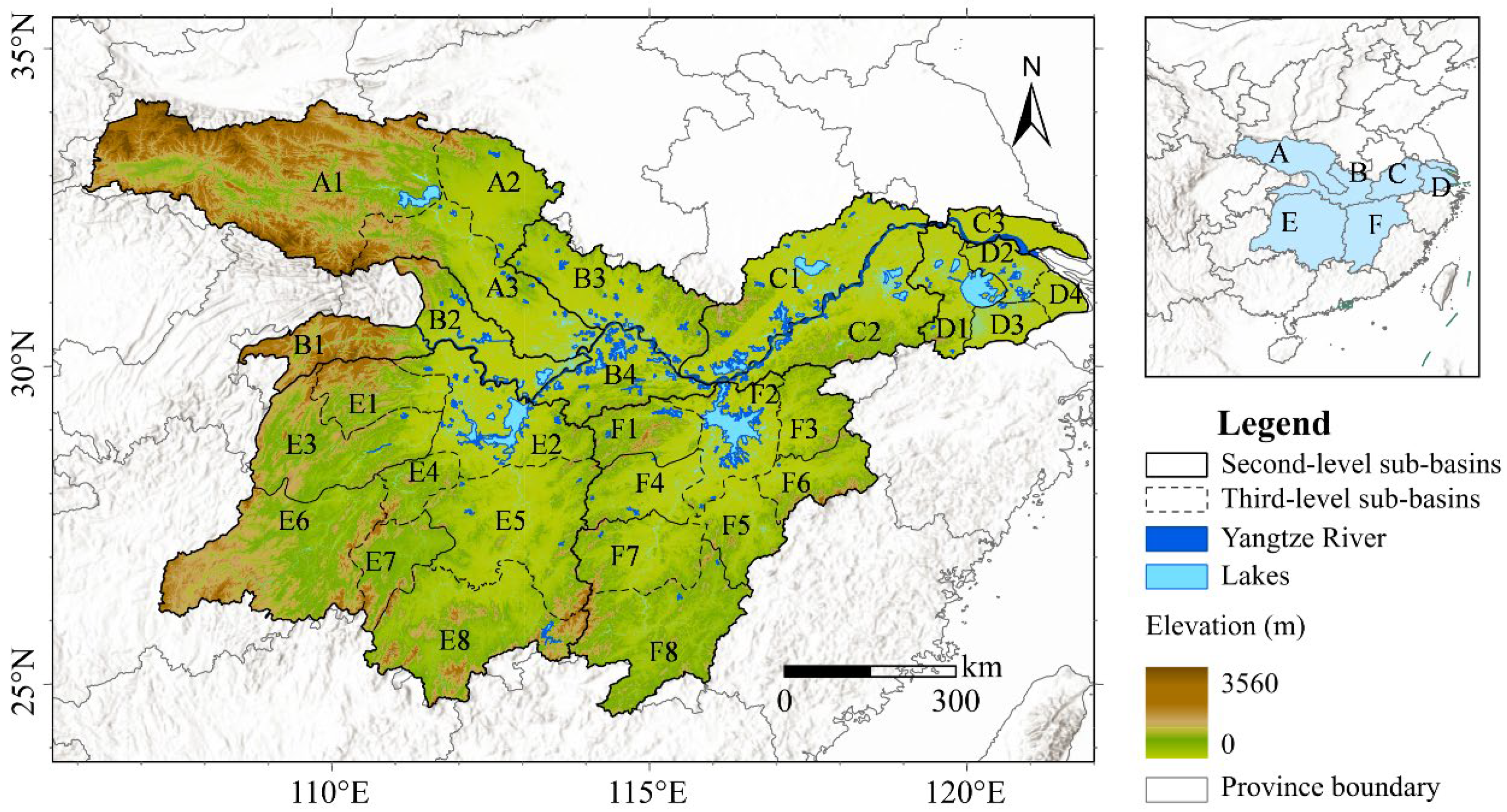
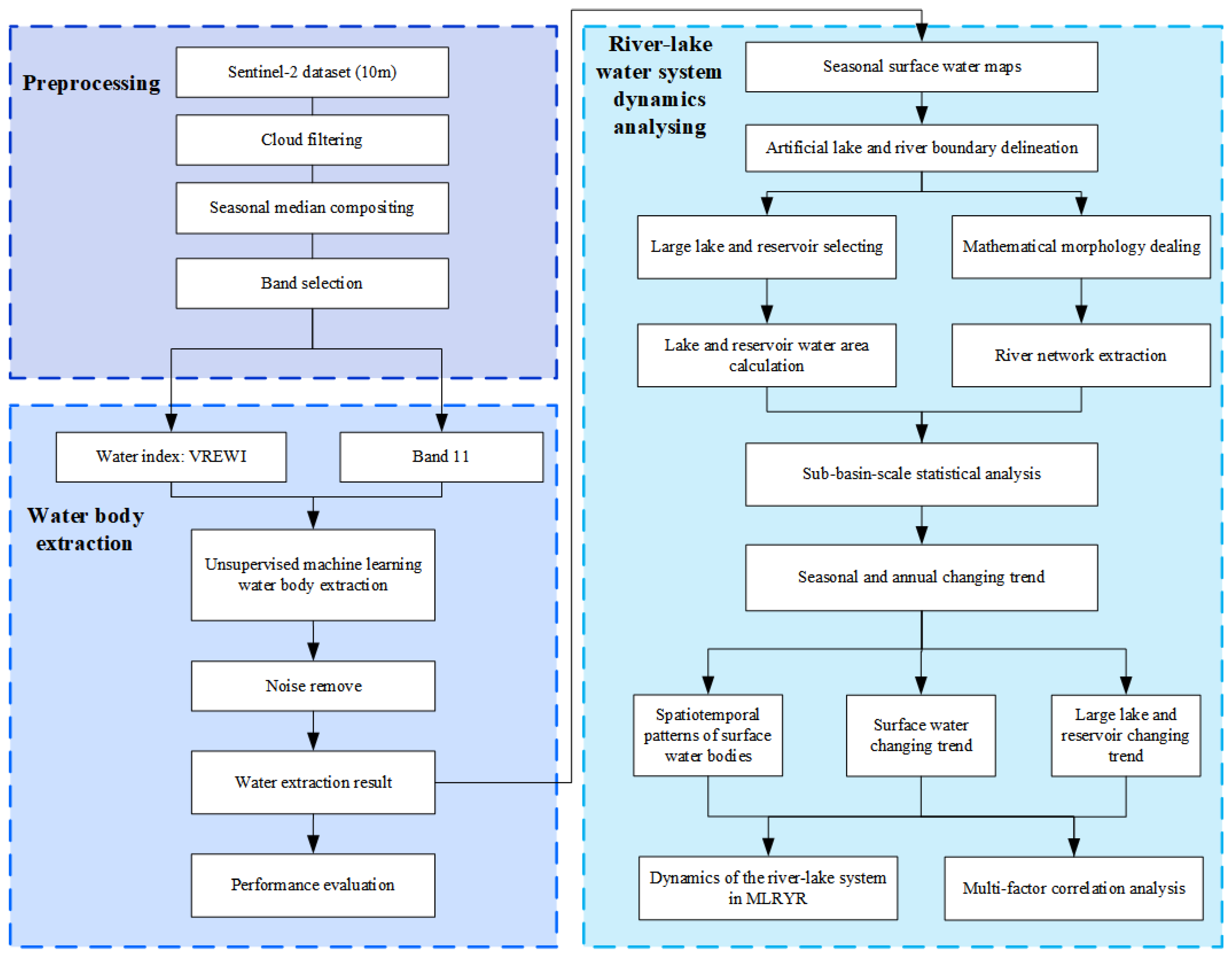

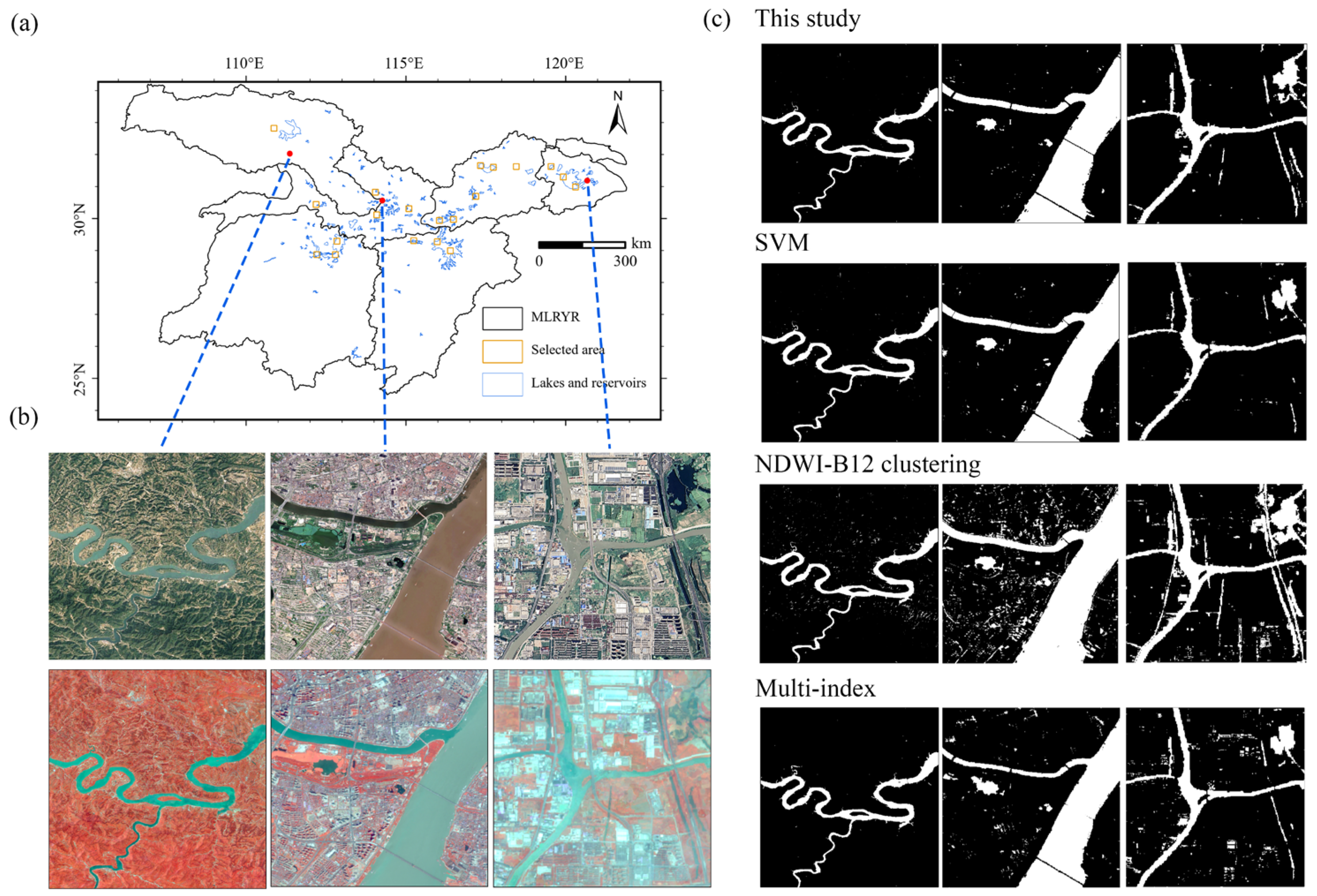
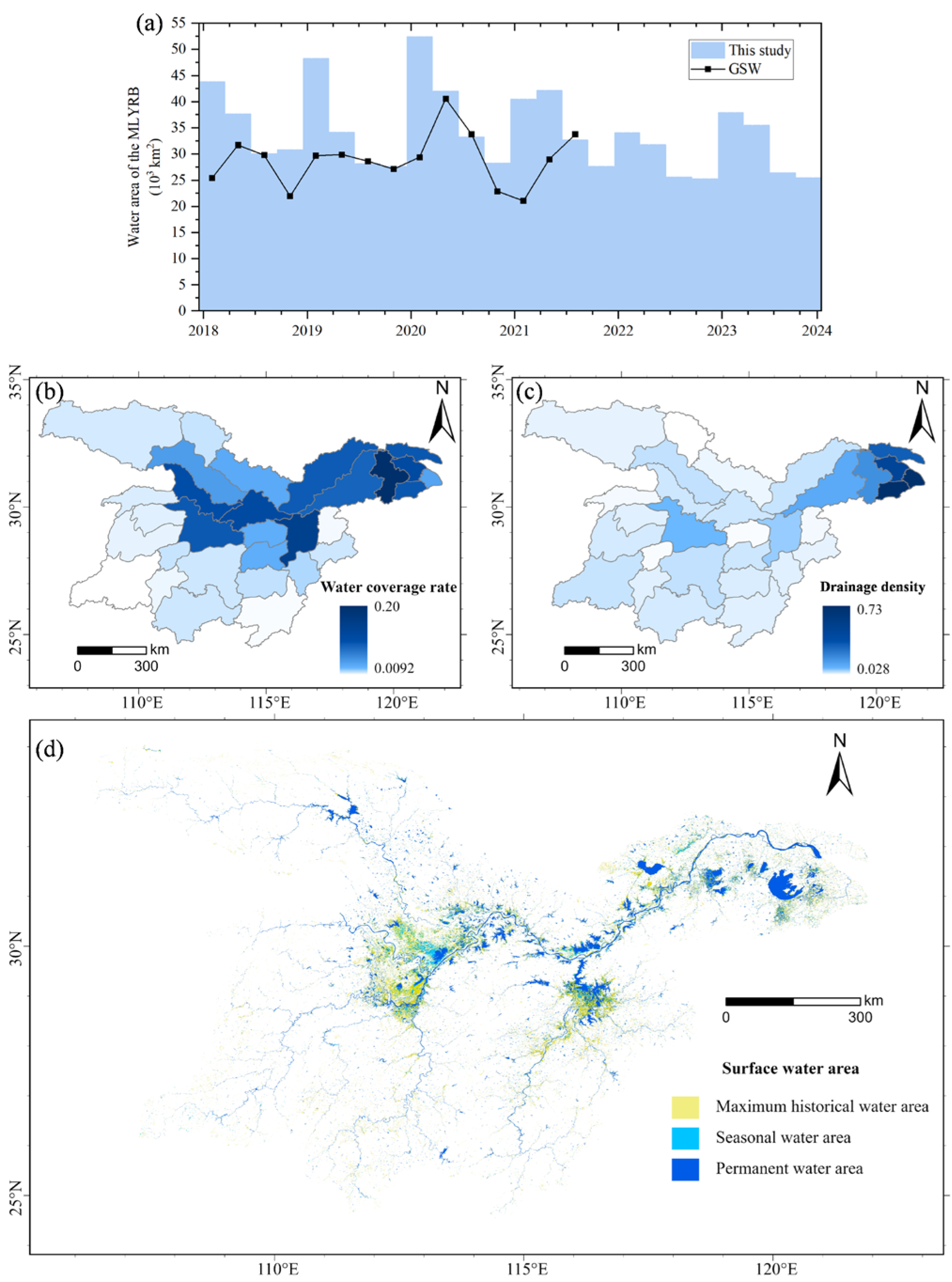
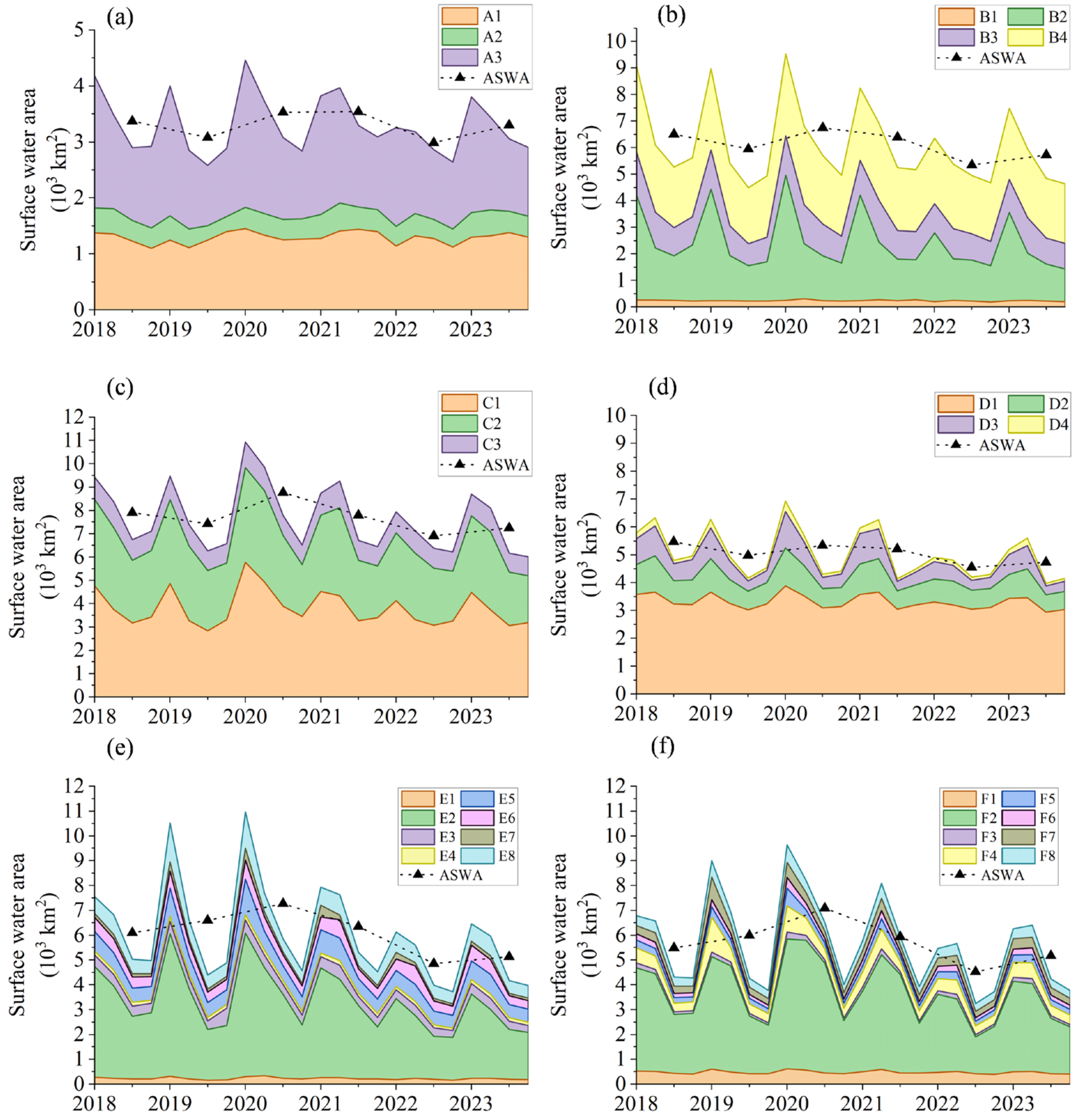


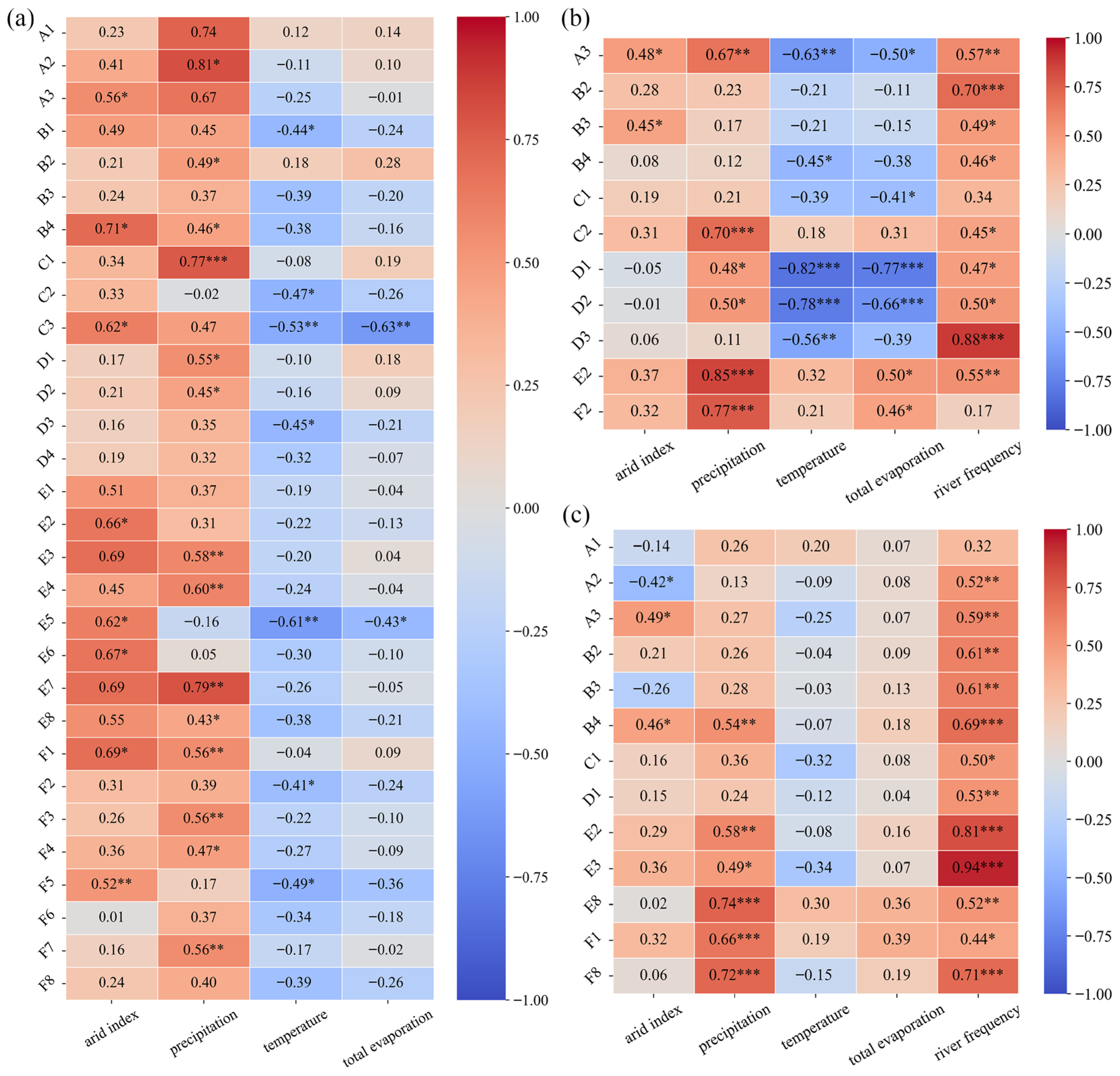
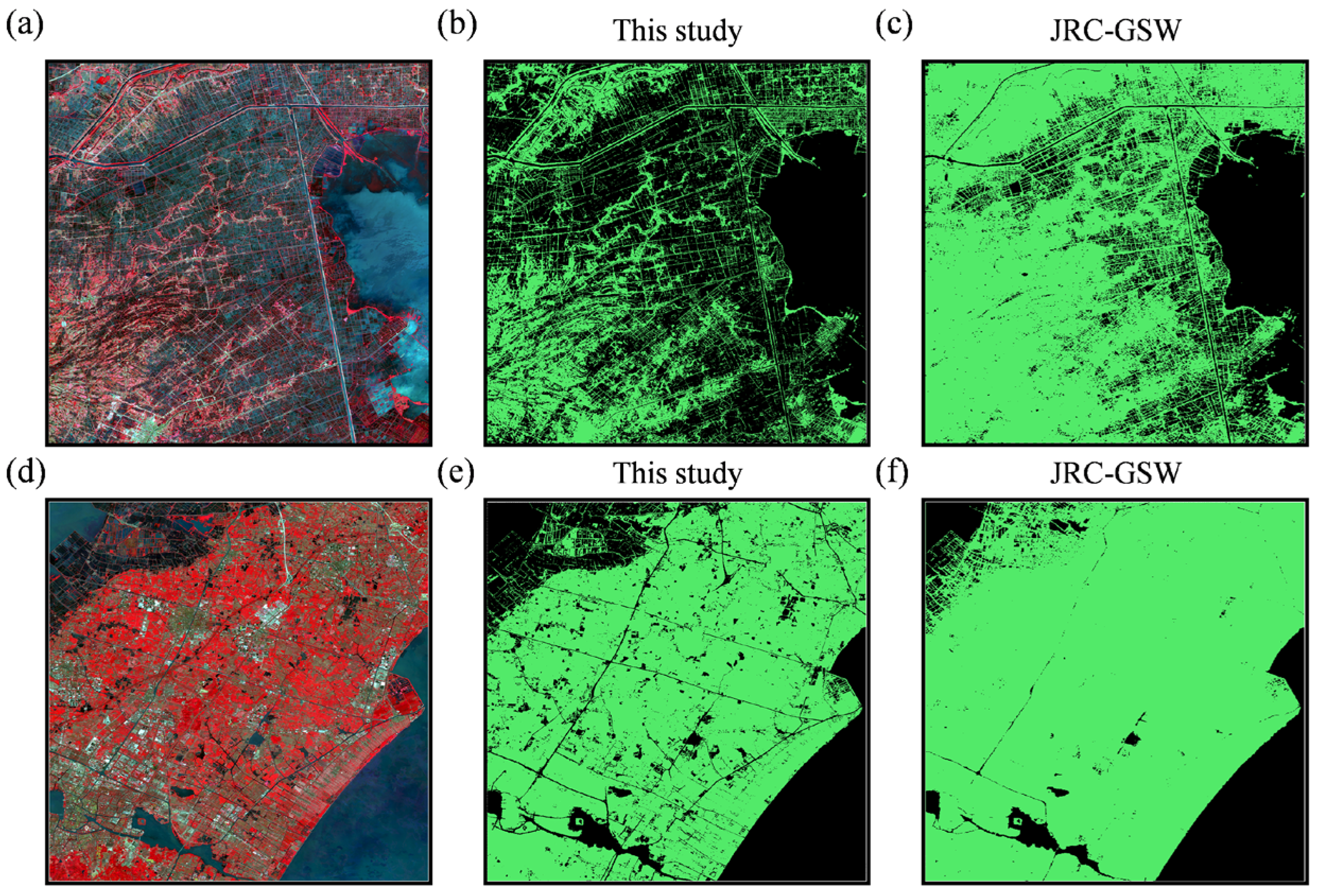
| Name | Usage | Reference |
|---|---|---|
| Global Surface Water (GSW) | Comparison | [42] |
| HydroLAKES | Lake/Reservoir extraction | [43] |
| National Major Lakes Distribution | Boundary adjustment | [44] |
| Global River Widths from Landsat (GRWL) | River extraction | [45] |
| ERA5-Land monthly dataset | Correlation analysis | [46] |
| This Study | SVM | NDWI-B12 Clustering | Multi-Index | |
|---|---|---|---|---|
| OA | 97.98% | 95.54% | 93.56% | 96.45% |
| PA | 98.02% | 89.96% | 91.07% | 92.67% |
| UA | 96.01% | 96.30% | 89.61% | 96.43% |
| MCC | 0.954 | 0.899 | 0.855 | 0.919 |
| Kappa | 0.954 | 0.899 | 0.855 | 0.919 |
Disclaimer/Publisher’s Note: The statements, opinions and data contained in all publications are solely those of the individual author(s) and contributor(s) and not of MDPI and/or the editor(s). MDPI and/or the editor(s) disclaim responsibility for any injury to people or property resulting from any ideas, methods, instructions or products referred to in the content. |
© 2025 by the authors. Licensee MDPI, Basel, Switzerland. This article is an open access article distributed under the terms and conditions of the Creative Commons Attribution (CC BY) license (https://creativecommons.org/licenses/by/4.0/).
Share and Cite
Qi, Z.; Yao, S.; Liu, X.; Ding, B.; Wang, H.; Jiang, Y.; Hu, J. Monitoring River–Lake Dynamics in the Mid-Lower Reaches of the Yangtze River Using Sentinel-2 Imagery and X-Means Clustering. Remote Sens. 2025, 17, 3421. https://doi.org/10.3390/rs17203421
Qi Z, Yao S, Liu X, Ding B, Wang H, Jiang Y, Hu J. Monitoring River–Lake Dynamics in the Mid-Lower Reaches of the Yangtze River Using Sentinel-2 Imagery and X-Means Clustering. Remote Sensing. 2025; 17(20):3421. https://doi.org/10.3390/rs17203421
Chicago/Turabian StyleQi, Zhanshuo, Shiming Yao, Xiaoguang Liu, Bing Ding, Hongyang Wang, Yuqi Jiang, and Jinpeng Hu. 2025. "Monitoring River–Lake Dynamics in the Mid-Lower Reaches of the Yangtze River Using Sentinel-2 Imagery and X-Means Clustering" Remote Sensing 17, no. 20: 3421. https://doi.org/10.3390/rs17203421
APA StyleQi, Z., Yao, S., Liu, X., Ding, B., Wang, H., Jiang, Y., & Hu, J. (2025). Monitoring River–Lake Dynamics in the Mid-Lower Reaches of the Yangtze River Using Sentinel-2 Imagery and X-Means Clustering. Remote Sensing, 17(20), 3421. https://doi.org/10.3390/rs17203421





